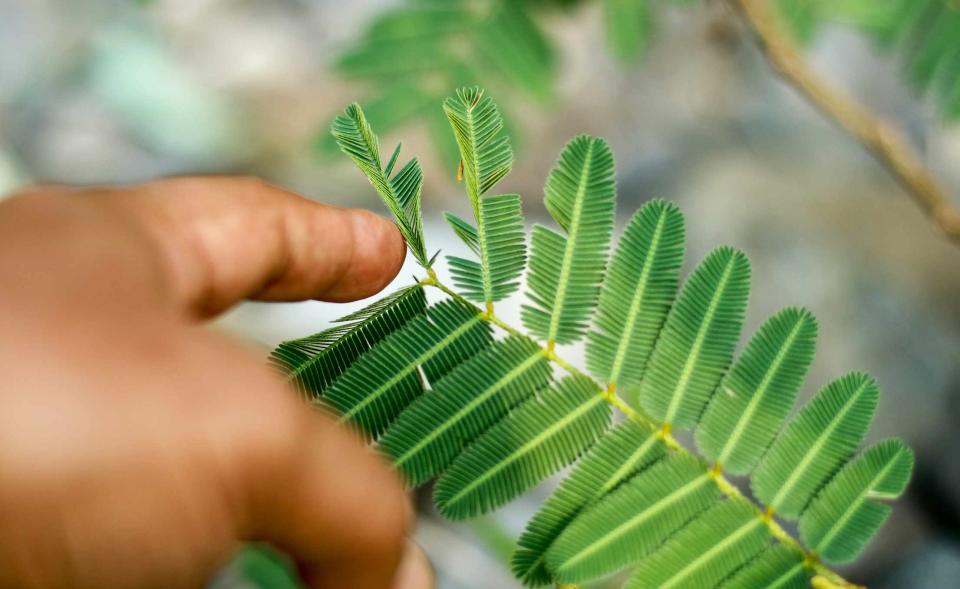Do Plants Have Feelings? A Science Explainer
Turns out they do. Now the question is, how complex?

JokoHarismoyo / Getty Images
The sensitive plant (Mimosa pudica) responds to human touch.One of the main distinctions between plants and animals is how they respond to stimuli. Humans have brains, where stimuli are understood and responses formed. “Emotional” responses are merely complex responses to complex social stimuli.
Plants lack a central nervous system but are still capable of processing information from external sources and responding to them. While plants don't have the same “feelings” that we do, they often remember stimuli and communicate with other plants about them.
Plant vs. Animal Feelings
Animals have neurons that transmit sensory feelings to a central nervous system (the brain). In humans, if your brain determines that those feelings are negative and dangerous, it sends a message back to their point of origin, causing you to react to avoid the continuation of that pain.
Animals like us have memories that allow us to avoid future pain. Memories of previous injuries don't trigger our bodies to produce adrenaline when the memory of that event returns.
Without a central nervous system, plants don't process sensations that way. But plants do react to negative or unpleasant sensations. Touch the leaves of the aptly named sensitive plant, Mimosa pudica, and it will close them. Prune a shrub, and the shrub will produce a callous around the wound, and likely stimulate new growth below the cut.
Plants retain memories of these events—not in a centralized brain, but distributed throughout the plant, closer to where the memory is needed. This is not merely a biophysical response to stimuli. Touch the leaves of a sensitive plant repeatedly, and the plant will no longer close its leaves. It has learned that the sensation is not a threat, and will retain that knowledge for up to 40 days.
Likewise, perennial flowering plants remember when to begin growing again in spring. Blooming before pollinators have re-emerged from winter will be unproductive. Blooming while it's still too cold could cause injury, even death. So many plants produce proteins that allow them to remember how many days it has been since they were last exposed to the cold, and only begin growing against when they deem it safe.
Interspecies Communication

oddonatta / Getty Images
The fine roots of a vascular plant look like a neural network.One of the most important and frequent inter-species relationships on Earth is the mycorrhizal association between fungi and plant roots—a relationship common to some 90% of plant species.
Through these networks, plants communicate with fungi and other plants, transferring nutrients and sending stress signals. Plants share important chemicals like nitrogen, carbon, and phosphorus through fungal networks. Aloe plants, tomatoes, and other plants notify each other with electrical signals as well—the plant equivalent of electronic communication—in order to induce plant growth, improve wound healing, among other reasons. This vast neural network underground puts the Internet to shame.
Plants also signal stress chemically through their leaves. When a herbivore nibbles on a sagebrush plant or an acacia tree, the plant emits toxins not only to ward off the nibbler but to signal to neighbor plants, who also begin emitting toxins.
Plants Listen to Each Other
Like many animals, some plants also communicate using sound. Sound is nothing more than vibrations in airwaves, something plant cells can evolve to produce and plant fibers to detect.
Recent studies of plant communication show that some plants emit high-frequency sound waves. Tomato and tobacco plants produce sounds during droughts or when their leaves are cut.
Plants can also be good listeners. Pea plants send their roots toward the sound of moving water—even if the sound is recorded and no water is actually present. And primrose flowers produce sweeter nectar when exposed to the sound (artificial or natural) of bees buzzing.
Most of a plant's life is lived underground. This is where plants do their thinking, in a decentralized network of sensory and memory cells—a nervous system that might contain over a trillion cells, about the same as in a human brain. Sadly, humans prize plants primarily for their reproductive organs—their flowers, fruits, and seeds—rather than their thinking and feeling parts. Like us, they use both to survive.
Frequently Asked Questions
If plants have memory, are they conscious?
Consciousness is the product of complex neural interactions within a central nervous system—which plants lack. But don't confuse memory with conscious thought. Even in humans, memory need not be conscious. Our memory T-cells learn to identify and fight off infectious organisms without any conscious human intervention. Vaccinations would not work if our cells did not have a memory function. In plants and humans, memory can happen at the cellular level, independent of consciousness.
Do plants feel emotions?
Plants don't have a limbic system, the human brain's function which creates emotions and memories out of sensory experience, so plants don't have complex emotions like happiness or sadness. When you mow the lawn, plants don't get mad at you, but they do produce that “mown grass” smell, which is a volatile compound released when grass is attacked by herbivores. The compound attracts carnivores which attack herbivores. So the grass doesn't get mad; it gets even.

